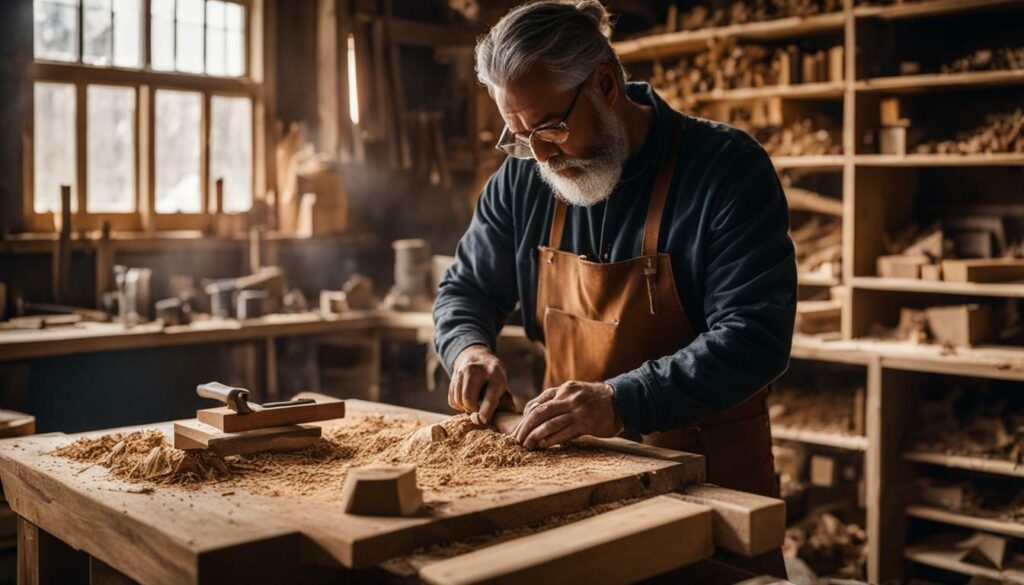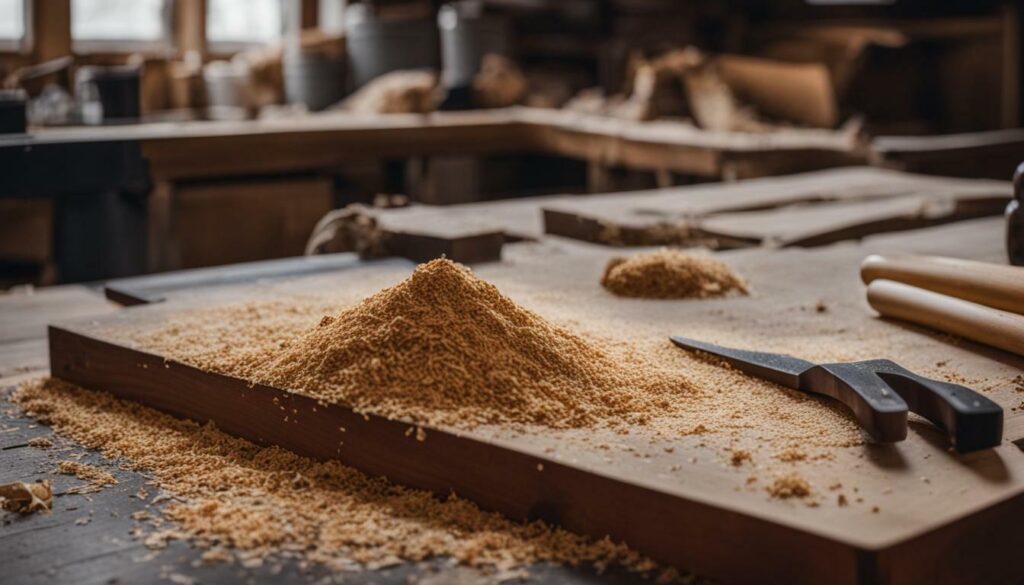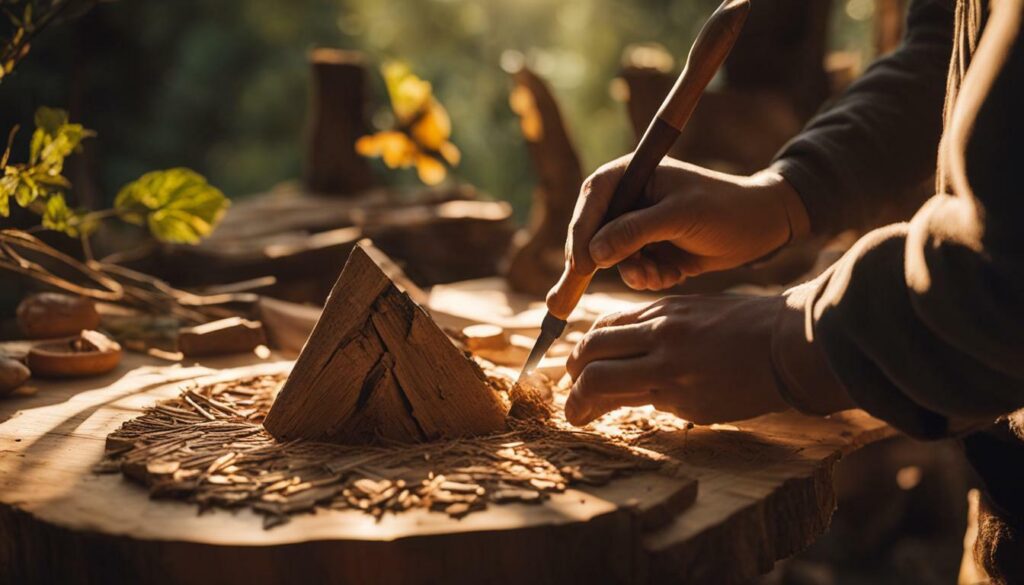Woodworking is a timeless craft that combines artistic expression with practicality. It is a skill that has been passed down through generations, allowing individuals to create beautiful and functional pieces using their creativity and technical abilities. The artistry in woodworking lies in the intricate designs, the choice of wood, and the attention to detail. Yet, it is also a craft that requires precision, knowledge of tools, and the ability to bring a vision to life.
Throughout history, woodworking has played a significant role in American culture, symbolizing the craftsmanship and innovative spirit of the nation. From the intricate furniture of the Colonial period to the sleek modern designs of today, woodworking has represented both the past and the present, reflecting the cultural identity and the evolving aesthetics of American society.
Woodworking offers more than just a finished product; it provides a myriad of benefits to those who engage in the craft. It fosters patience, as each piece requires time and dedication to complete. It enhances problem-solving skills, as woodworkers must overcome challenges and find creative solutions along the way. And perhaps most importantly, it brings a sense of accomplishment and pride when a project is finished and admired for its beauty and functionality.
Key Takeaways:
- Woodworking combines artistic expression with practicality.
- Woodworking is deeply rooted in American history and culture.
- Engaging in woodworking promotes patience, problem-solving skills, and a sense of accomplishment.
- Woodworking can be pursued as both a hobby and a profession, offering diverse opportunities.
- The craft requires the right tools and techniques to unleash creativity and artistic expression.
Completing a woodworking project is a gratifying experience, as it allows individuals to showcase their artistic expression and craftsmanship. Whether it’s a meticulously carved wooden sculpture or a beautifully crafted piece of furniture, the end result is a testament to the skill and dedication of the woodworker.
In today’s digital age, where distractions abound, woodworking provides a much-needed respite. It offers a moment of mindfulness and focus, allowing individuals to disconnect from screens and connect with the tactile nature of the craft. Woodworking becomes a meditative experience, where the sound of saws and the smell of fresh wood create a serene atmosphere.
Furthermore, woodworking is not just about the final product; it is a journey of learning and growth. Aspiring woodworkers develop valuable skills such as carpentry and problem-solving along the way. Each project becomes an opportunity to refine techniques, explore new designs, and discover personal potential.
In conclusion, woodworking is a fulfilling and rewarding endeavor that combines creativity, craftsmanship, and utility. It is both an art and a craft, weaving together the intricacies of artistic expression and practical application. Whether pursued as a hobby or a profession, woodworking offers a timeless and profound connection to the beauty of wood and the satisfaction of creating something remarkable.
Woodworking: A Historical Perspective
Woodworking has played a significant role in American history and culture, representing both artistic expression and skilled craftsmanship. From the early settlers building log cabins to the intricate furniture of the Victorian era, woodworking has been a cornerstone of American craftsmanship.
Throughout history, woodworking has not only served practical purposes but also served as a means of artistic expression. The intricate carvings and exquisite details found in antique furniture showcase the creativity and talent of the woodworkers of the past.

Woodworking is a craft that embodies the spirit of American ingenuity. It reflects the values of hard work, attention to detail, and a deep appreciation for the natural beauty of wood.
Woodworking has also played a significant role in shaping American cultural identity. From the distinct architectural styles found in different regions to the iconic wooden crafts created by Native American tribes, woodworking has left an indelible mark on the nation’s history.
| Period | Woodworking Style |
|---|---|
| Colonial Era | Simple, functional designs influenced by European craftsmanship |
| Victorian Era | Ornate, decorative furniture with intricate carvings and elegant details |
| Arts and Crafts Movement | Focus on craftsmanship, simplicity, and the natural beauty of wood |
| Mid-Century Modern | Clean lines, minimalistic designs, and innovative use of materials |
Woodworking continues to be a beloved craft in modern times, with artisans and hobbyists alike carrying on the traditions passed down through generations. Whether it’s creating unique pieces of furniture, intricate wood carvings, or functional wooden objects, woodworking allows individuals to express their creativity while honing their skills.
As time goes on, the tradition of woodworking as both an art and a craft will continue to evolve, reflecting the changing tastes and influences of each generation. From the historical significance to the present-day pursuit of woodworking, the craft remains an essential part of American culture.
Woodworking Benefits: More Than Just Sawdust
Engaging in woodworking not only allows you to express your artistic side but also nurtures patience, sharpens problem-solving abilities, and instills a profound sense of accomplishment. The craft of woodworking offers a multitude of benefits that go beyond the final product. As you work with various tools and techniques, you embark on a journey of self-discovery and personal growth.
Patience is a virtue that is honed through woodworking. Each piece requires careful attention to detail and meticulous craftsmanship. From meticulously sanding each surface to patiently waiting for glue to dry, woodworking teaches you the value of patience and the rewards it brings. As you work through the process, you learn to embrace the beauty of taking your time and savoring the journey.
Woodworking is not just about creating beautiful objects; it also challenges your problem-solving skills. With each project, you encounter unique obstacles and find creative solutions. Whether it’s figuring out the best joinery technique or troubleshooting a design flaw, woodworking forces you to think outside the box and develop your problem-solving abilities. This mental exercise helps sharpen your critical thinking skills and enhances your ability to approach challenges from different angles.
Completing a woodworking project is a moment of pure satisfaction. Holding a finished piece in your hands, knowing that you have created something beautiful and functional, instills a profound sense of accomplishment. The combination of artistry and craftsmanship is a testament to your dedication, skill, and creativity. It’s a tangible reminder of what you are capable of achieving.
Woodworking Benefits: More Than Just Sawdust
| Benefits | Description |
|---|---|
| Patience | Woodworking nurtures patience through attention to detail and the process of waiting for glue to dry. |
| Problem-Solving | Woodworking challenges your ability to find creative solutions and think critically. |
| Sense of Accomplishment | Completing a woodworking project provides a profound sense of satisfaction and pride. |
Woodworking is a multifaceted craft that offers more than just sawdust. The skills and mindset developed through woodworking can be applied to various aspects of life, making it a truly valuable and rewarding pursuit.

Whether you choose to pursue woodworking as a soothing hobby or a fulfilling profession, the possibilities within this craft are boundless. Woodworking offers a unique blend of creativity, craftsmanship, and utility, making it an art form and a practical skill.
As a hobby, woodworking allows you to escape the hustle and bustle of everyday life and immerse yourself in a meditative process. The sound of sawing, the feel of smoothing the wood, and the satisfaction of creating something with your own hands can be immensely rewarding. It provides a sense of accomplishment as you see your vision come to life in each finished piece.
However, woodworking can also be a lucrative profession. With the right skills and knowledge, you can explore various trades and industries related to woodworking. From furniture making to cabinetry, there is a demand for skilled woodworkers who can create custom pieces with precision and artistry. The craftsmanship and attention to detail required in woodworking are highly valued in the market.
Exploring Trades and Industries
If you decide to pursue woodworking as a profession, you can find opportunities in a wide range of trades and industries. Here are just a few examples:
| Trade/Industry | Description |
|---|---|
| Furniture Making | Create unique and custom furniture pieces for individuals and businesses. |
| Carpentry | Construct and install wooden structures and frameworks in buildings. |
| Cabinetmaking | Design and build cabinets, shelves, and other storage solutions. |
| Woodworking Education | Teach others the art and techniques of woodworking through workshops or classes. |
These are just a few examples, and the possibilities within woodworking are vast. Whether you choose to carve intricate sculptures or construct sturdy furniture, woodworking allows you to express your creativity and skill while providing practical and beautiful solutions.
So, whether you embrace woodworking as a hobby or a profession, you’ll find immense satisfaction in the blend of art and craft that this timeless practice offers. Let your creativity flow and embark on a journey of self-discovery through woodworking.

With the right tools and techniques at your disposal, woodworking becomes a magnificent art form, allowing you to breathe life into raw wood. From shaping intricate details to creating seamless joints, the craftsmanship involved in woodworking is truly awe-inspiring.
One of the essential tools in a woodworker’s arsenal is the chisel. This versatile instrument allows you to carve, shape, and smooth wood surfaces with precision. As you delicately chip away at the wood, the chisel becomes an extension of your creative vision.
Another indispensable tool is the hand plane, which helps you achieve flat and smooth surfaces. By skillfully maneuvering the hand plane across the wood, you are able to shape and refine it to perfection. The rhythmic swish of the plane against the grain becomes a symphony of craftsmanship.
When it comes to techniques, the art of joinery takes center stage. Dovetail joints, mortise and tenon joints, and box joints are just a few examples of the intricate connections that can be achieved through woodworking. These techniques require precision and patience, ensuring that each joint is not only structurally sound but visually appealing as well.
| Woodworking Tools | Woodworking Techniques |
|---|---|
| Chisel | Dovetail Joints |
| Hand Plane | Mortise and Tenon Joints |
| Saw | Box Joints |
As you embark on your woodworking journey, remember that these tools and techniques are your keys to unlocking the immense potential of this craft. They provide the foundation for your artistic expression and allow you to transform a simple piece of wood into a masterpiece that will stand the test of time.

“Woodworking gives you the power to turn your creative ideas into tangible reality. The process of shaping, carving, and joining wood is an art form that unleashes boundless creativity.” – Woodworking Enthusiast
Sharing the Beauty: Completing a Woodworking Project
The culmination of a woodworking project is an exhilarating experience, as you witness the transformation of raw materials into a stunning work of art, ready to be admired and cherished by others. Whether it’s a meticulously crafted piece of furniture, an intricately designed wooden sculpture, or a hand-carved masterpiece, the satisfaction derived from completing a woodworking project is unparalleled.
Woodworking offers a unique opportunity to express your creativity and showcase your artistic skills. Each stroke of the chisel, each cut of the saw, and each careful joinery represents a labor of love and attention to detail. As you bring your vision to life, you become a part of the wood, breathing life into its natural beauty and creating a lasting legacy.

With woodworking, there’s a deep sense of fulfillment that comes from turning a simple piece of lumber into something extraordinary. The combination of craftsmanship and artistic expression is evident in every curve, every contour, and every finish. It is this harmonious blend of artistry and practicality that makes woodworking a truly captivating pursuit.
Woodworking as Meditation: A Break from the Digital Age
In a world dominated by screens and constant noise, woodworking offers a sanctuary for tranquility, guiding you towards a state of mindfulness and serenity. Engaging in this craft allows you to disconnect from the digital realm and reconnect with the raw beauty of nature’s most versatile material: wood. As you delve into the art of woodworking, the rhythmic sound of the saw, the scent of freshly cut timber, and the tactile sensation of shaping wood become a meditative experience.
Woodworking not only demands your focus, but it also rewards your efforts with a renewed sense of purpose and accomplishment. The process of transforming raw materials into intricate pieces requires patience, precision, and attention to detail. As you navigate the grain of the wood and refine your technique, you’ll find yourself fully engrossed in the present moment, leaving behind the distractions and stresses of modern life.

Embracing Imperfections: a Reflection of Life
Woodworking teaches us to embrace imperfections and find beauty in the unique characteristics of each piece of wood. Just as life is filled with unexpected twists and turns, woodworking reminds us that even the knots and blemishes can be transformed into something extraordinary. The craft encourages us to adapt, problem-solve, and see the potential in every challenge we encounter. Each stroke of the plane or stroke of the chisel becomes a metaphor for navigating the complexities of existence.
“Woodworking is a journey,” says renowned woodworker and artist, John Doe.
“In every piece of wood lies a story waiting to be uncovered. The process of shaping and refining the wood is a reflection of our own growth and evolution. It’s a conversation between the craftsman and the material, resulting in a manifestation of both their essences.”
| The Benefits of Woodworking as Meditation |
|---|
| Enhances focus and mindfulness |
| Provides a break from digital distractions |
| Promotes stress relief |
| Fosters problem-solving skills |
Woodworking is not just a craft; it is a transformative journey that encompasses both artistry and practicality. As you engage in this ancient practice, you will discover the joy of creating something meaningful with your own hands, while also finding solace in the serene world of wood. So, put down your smartphone, pick up a chisel, and let the art of woodworking lead you to a state of tranquility and fulfillment.
Learning and Development: Woodworking as a Skill-Building Journey
Engaging in the artistry of woodworking not only allows you to create masterful pieces but also serves as a transformative journey of learning and skill-building. With its rich history and versatile nature, woodworking offers a plethora of opportunities for personal growth and development.
Woodworking is a craft that requires patience, precision, and problem-solving skills. As you embark on your woodworking journey, you’ll learn to measure, cut, shape, and assemble materials with meticulous attention to detail. The process of crafting a wooden masterpiece involves trial and error, honing your craftsmanship and teaching you to adapt and innovate along the way.
Through woodworking, you’ll develop valuable skills that extend beyond the realm of carpentry. The ability to problem-solve and find creative solutions becomes second nature as you encounter challenges and find ways to overcome them. Each completed project becomes a testament to your growing expertise, fueling your confidence and inspiring you to take on more complex designs.
| Key Skills Developed in Woodworking |
|---|
| Carpentry |
| Problem-solving |
| Attention to detail |
| Adaptability |
| Creativity |
Woodworking is not only about the end result; it’s about the journey of self-discovery and continuous learning. Each project presents an opportunity to expand your skillset and explore new techniques. Whether you’re crafting furniture, carving sculptures, or building architectural structures, woodworking allows you to push the boundaries of your creativity and discover hidden talents.
As you embark on your skill-building journey, embrace the challenges and celebrate the milestones. Woodworking is a craft that nurtures patience, fosters innovation, and ultimately rewards you with a sense of accomplishment that comes from creating something remarkable with your own hands. So, pick up your tools, unleash your creativity, and let the transformative power of woodworking shape your path to mastery.

- Woodworking is a journey that combines skill-building and creativity.
- It hones problem-solving abilities and fosters attention to detail.
- Woodworking nurtures adaptability and encourages innovative thinking.
- Each project presents an opportunity for self-discovery and growth.
- Through woodworking, you can develop valuable skills beyond carpentry.
Conclusion
Woodworking is the perfect marriage of art and craft, offering endless opportunities for creative expression while embodying the true essence of craftsmanship. It is a timeless craft that has played a significant role in American history, representing both the skill and cultural identity of its practitioners.
Whether pursued as a hobby or a profession, woodworking provides numerous benefits beyond just the creation of beautiful and functional objects. It fosters patience, as each project requires careful attention to detail and precision. It enhances problem-solving skills, as woodworkers are constantly faced with challenges that require ingenuity and creative thinking.
Completing a woodworking project brings immense satisfaction and joy, as it represents the culmination of skill, creativity, and hard work. Sharing these creations with others adds another layer of fulfillment, as they can appreciate the beauty and artistic expression embedded in each finished piece.
Furthermore, woodworking offers a much-needed break from the digital age, providing a meditative experience that promotes focus, mindfulness, and stress relief. In a world filled with constant distractions, the act of working with wood allows you to connect with the present moment and engage in a tactile and tangible form of self-expression.
Moreover, woodworking serves as a skill-building journey, enabling individuals to acquire and develop valuable abilities such as carpentry and problem-solving. Each project becomes an opportunity for learning and growth, fostering a sense of personal achievement and self-discovery.
In conclusion, woodworking combines art, craft, and utility in a way that is both fulfilling and rewarding. It allows for the unleashing of creativity while cultivating the meticulousness and precision required of a true craftsman. So, whether you are a seasoned woodworker or just starting out, embrace the beauty of woodworking and let your creativity flourish.
FAQ
Q: Is woodworking considered an art or a craft?
A: Woodworking is a unique blend of both art and craft, combining artistic expression with practical skill.
Q: What is the historical significance of woodworking?
A: Woodworking has played a significant role in American history, representing craftsmanship and cultural identity.
Q: What are the benefits of woodworking?
A: Woodworking fosters patience, enhances problem-solving skills, and provides a sense of accomplishment.
Q: Can woodworking be pursued as a hobby or profession?
A: Yes, woodworking can be enjoyed as a hobby or pursued professionally, with opportunities in various trades and industries.
Q: What tools and techniques are involved in woodworking?
A: Woodworking requires the right tools and techniques, allowing for the unleashing of creativity and artistic expression.
Q: What is the satisfaction of completing a woodworking project?
A: Completing a woodworking project brings joy and satisfaction, allowing you to share the beauty and artistic expression of your work with others.
Q: Does woodworking offer a break from the digital age?
A: Yes, woodworking provides a meditative experience that offers a break from digital distractions, encouraging focus and mindfulness.
Q: How does woodworking contribute to learning and development?
A: Woodworking is a means of learning and developing valuable skills, such as carpentry and problem-solving abilities, while also fostering personal growth and self-discovery.
How Does the Physicality of Woodworking Enhance the Artistic Aspect?
The physicality of woodworking as a physical craft plays a crucial role in enhancing the artistic aspect of this traditional art form. The tactile experience of shaping and working with wood allows artisans to connect intimately with their medium. The hands-on nature of woodworking enables artists to draw inspiration from the natural grain, texture, and unique characteristics of the wood, resulting in truly captivating artistic creations.

